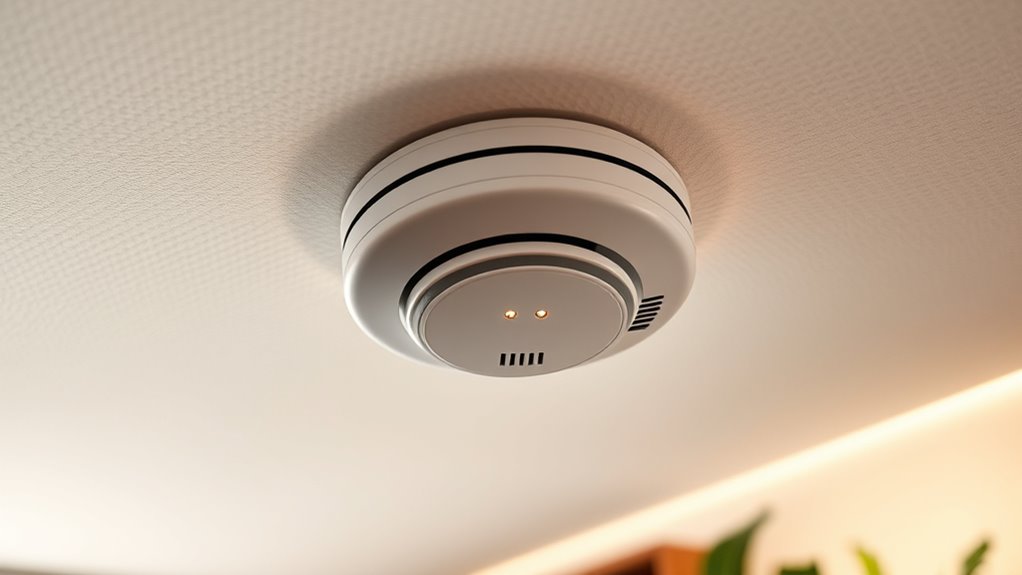IoT smoke detectors send silent, lifesaving signals by wirelessly transmitting alerts through secure protocols like Zigbee or Z-Wave, instantly notifying your smartphone or connected device. They use sensors to detect smoke or heat changes and communicate with your smart home system without loud sirens, reducing panic. Through encrypted, low-latency connections, these detectors guarantee quick, trusted alerts even during power outages. To discover how these systems work seamlessly together, continue exploring the details below.
Key Takeaways
- IoT smoke detectors use secure wireless protocols like Zigbee or Z-Wave to transmit alerts silently to connected devices.
- They send real-time notifications directly to smartphones or smart home systems without loud alarms.
- Encrypted data ensures security and privacy during silent alert transmission.
- Integration with smart home ecosystems enables automated responses and coordinated safety measures.
- Backup power sources and low-latency communication guarantee continuous, discreet lifesaving signals during emergencies.
Understanding the Core Components of IoT Smoke Detectors
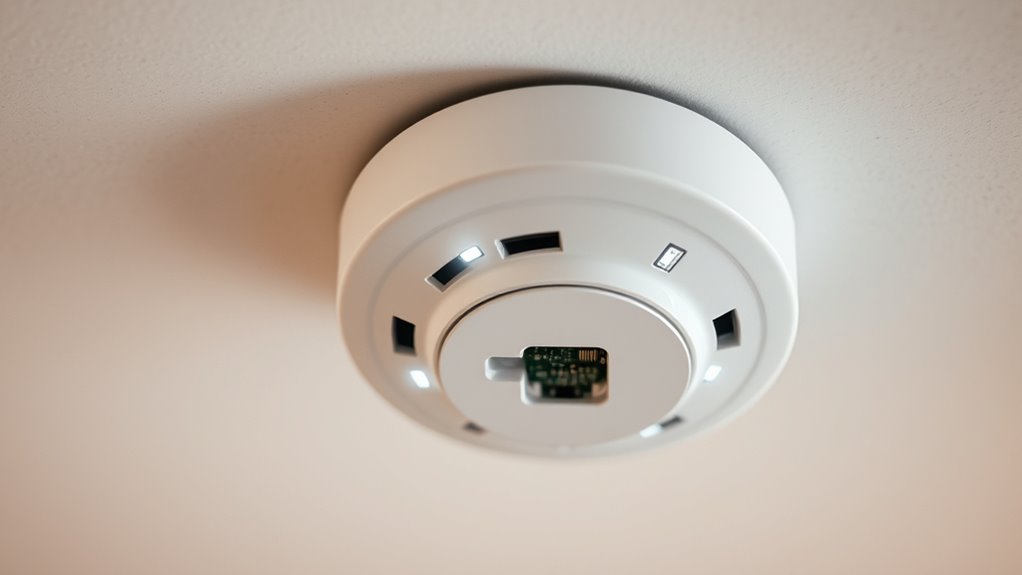
To understand how IoT smoke detectors work, it’s essential to know their core components. The sensor is the heart of the device, detecting smoke particles or heat changes. Regular sensor calibration is crucial to ensure accurate readings over time, preventing false alarms or missed detections. The detector’s battery life also plays a vital role; many models use long-lasting batteries, some with alerts to notify you when they need replacing. This guarantees continuous operation, especially during power outages. The microcontroller processes sensor data, determining when to trigger an alarm. Additionally, built-in power management features optimize battery use, extending device lifespan. High refresh rates in sensors help them quickly detect smoke or heat changes, providing faster alerts. Understanding these components helps you appreciate how IoT smoke detectors reliably protect your home by providing early warnings and maintaining optimal performance.
How Connectivity Enables Real-Time Monitoring
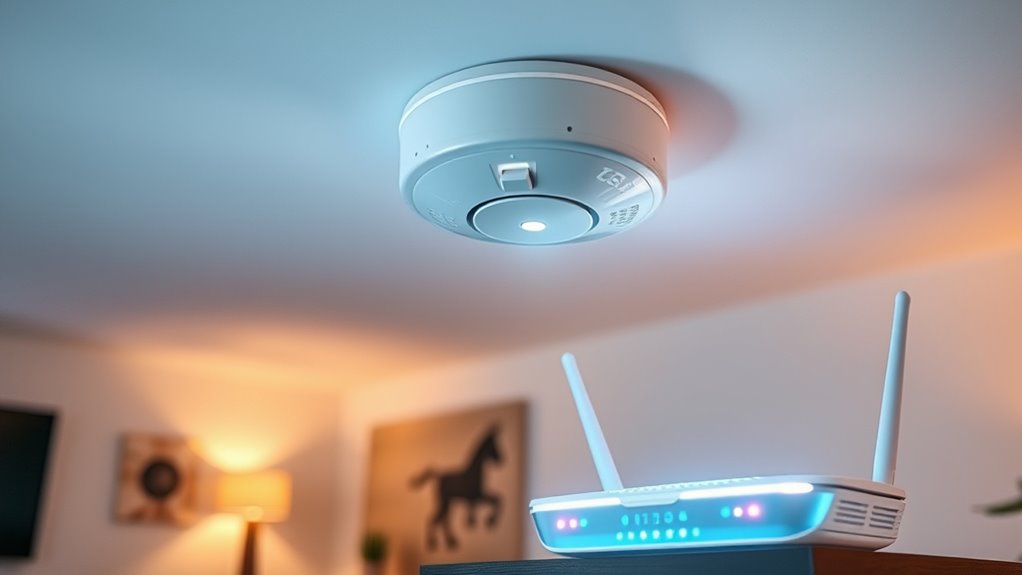
Connectivity allows your smoke detector to send alerts instantly through wireless data transmission, keeping you informed no matter where you are. With remote alert systems, you receive notifications directly on your phone, so you can act quickly even if you’re away. Continuous system monitoring guarantees your detector stays active and reliable, providing peace of mind at all times.
Wireless Data Transmission
Wireless data transmission is the backbone of real-time monitoring in IoT smoke detectors, allowing instant communication between the device and monitoring systems. This process relies on robust wireless protocols that guarantee reliable data transfer, even in challenging environments. These protocols handle the transmission of sensor readings, alert signals, and status updates quickly and efficiently. To keep your data safe from eavesdropping or tampering, encryption is integrated into the transmission process. Data encryption secures sensitive information, maintaining privacy and integrity during wireless exchanges. Without these secure and efficient wireless protocols and encryption, real-time monitoring wouldn’t be possible, leaving crucial signals delayed or vulnerable. Implementing professional-grade equipment ensures optimal performance and reliability in data transmission. This seamless data flow ensures you’re promptly alerted, enhancing safety and response times during emergencies.
Remote Alert Systems
How does connectivity guarantee you receive immediate alerts from your smoke detector? It enables real-time communication with remote alert systems, instantly notifying you via smartphone or connected devices. Smart home integration ensures alerts are seamlessly delivered, whether you’re at home or away, so you can act quickly. These systems use reliable wireless data transmission to send alerts instantly, reducing response times. Additionally, connectivity helps optimize battery life by managing power consumption during idle periods, ensuring your smoke detector remains functional when needed most. With remote alerts, you’re always in the loop, regardless of your location, providing peace of mind and faster response to potential hazards. This integration of connectivity, smart technology, and power management makes modern smoke detectors more effective and user-friendly. Proper Self Watering Plant Pots can also help maintain your plants’ health with minimal effort, highlighting the importance of reliable systems in everyday life.
Continuous System Monitoring
Continuous system monitoring is made possible through real-time data transmission, allowing your smoke detector to constantly track its status and environmental conditions. This connectivity ensures you receive instant alerts and helps maintain ideal performance. Regular sensor calibration keeps detection accurate, preventing false alarms or misses. Monitoring battery lifespan means you’ll be notified before power runs out, avoiding silent failures. Additional costs for equipment upgrades or smart home integrations can enhance system capabilities. Key benefits include:
- Instant alerts for smoke or fire detection
- Automated sensor calibration reminders
- Alerts for low battery life
- Continuous performance tracking for safety assurance
The Role of Wireless Protocols in Silent Signaling
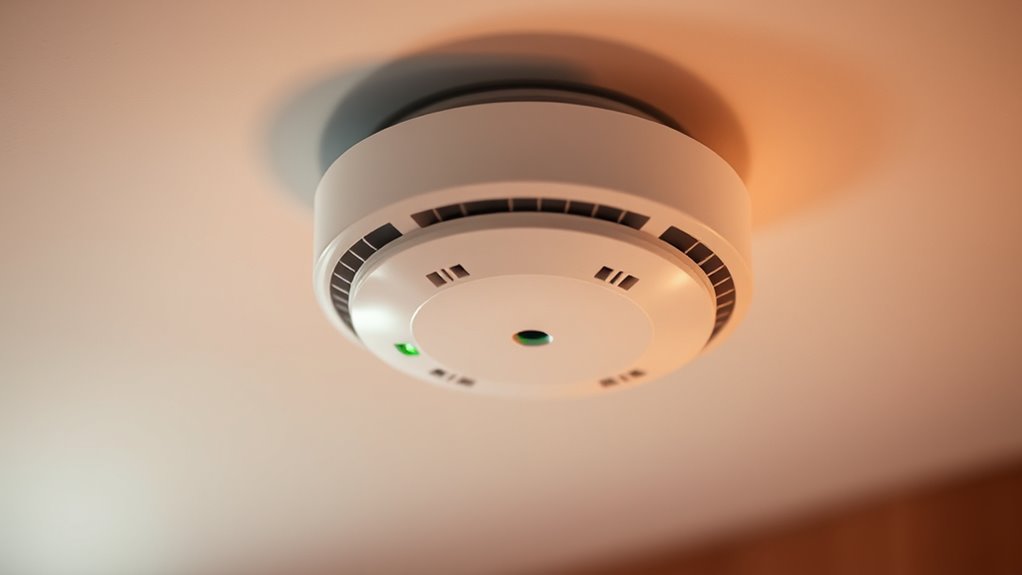
Because IoT smoke detectors rely on silent, real-time communication to alert occupants, the choice of wireless protocols is essential for effective silent signaling. These protocols determine how quickly and reliably signals are transmitted without disturbing the environment. Low-latency wireless protocols like Zigbee, Z-Wave, or Bluetooth Low Energy are often preferred because they enable rapid, secure data exchange. They ensure that alerts reach your smart devices instantly, even in the background. The reliability of these protocols minimizes false alarms and missed notifications, providing peace of mind. Additionally, Kia Tuning involves optimizing electronic systems, which highlights the importance of choosing robust wireless protocols for critical safety communications. By selecting the right wireless protocols, manufacturers guarantee that silent signaling works seamlessly, allowing your smoke detector to alert you immediately without causing unnecessary noise or disruption.
Integration With Smart Home Ecosystems
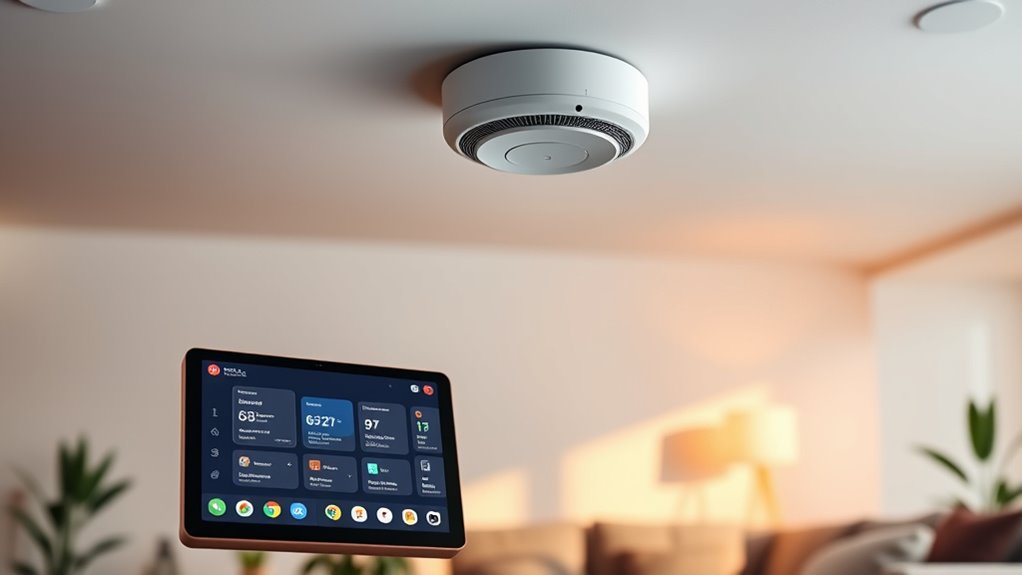
When you connect your smoke detector to a smart home system, you get seamless device connectivity that makes managing alerts easier. You can receive notifications on your phone or other devices without needing to check multiple apps. This integration also allows centralized alert management, so you stay informed no matter where you are. Additionally, dog breeds like the loyal Golden Retriever are often used in therapy roles, exemplifying the importance of reliable alert systems in ensuring safety for all family members.
Seamless Device Connectivity
Seamless device connectivity allows IoT smoke detectors to integrate effortlessly with your smart home ecosystem, enhancing safety and convenience. By using reliable wireless protocols like Zigbee or Z-Wave, your detectors communicate smoothly with other devices. This integration enables you to monitor and control your smoke detectors via a single app or voice commands. Variety of materials available ensures compatibility with different smart home setups. Consider these key benefits: 1. Quick setup with compatible smart home platforms 2. Automatic device recognition and pairing 3. Real-time alerts sent directly to your phone 4. Coordinated responses with other smart devices, like alarms or thermostats
This seamless connectivity ensures your smoke detector is always part of your home’s safety network, providing peace of mind with minimal effort.
Centralized Alert Management
Centralized alert management allows your smart home ecosystem to coordinate and respond effectively to smoke detections. When an IoT smoke detector senses fire, it communicates with other devices, activating emergency protocols and alerting you instantly. This integration guarantees fire safety by automating responses like opening doors or shutting off HVAC systems. It also consolidates alerts, preventing confusion during emergencies. For effective operation, understanding the best IoT devices and their compatibility is crucial.
Remote Alerts: Sending Notifications to Smartphones and Devices
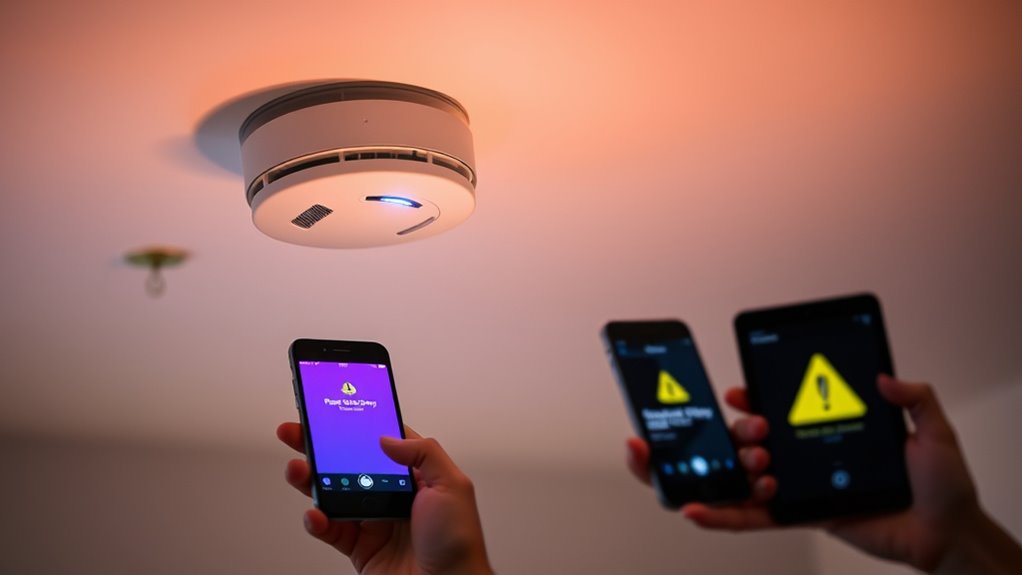
Remote alerts allow your IoT smoke detectors to instantly notify you of potential dangers, even if you’re not at home. This quick communication enhances fire safety by ensuring you’re aware of issues immediately. When an alarm triggers, your device sends notifications straight to your smartphone or connected devices, so you can act swiftly. To keep these alerts effective, regular alarm maintenance is essential, ensuring your system responds accurately. Key points to remember include:
- Immediate notifications help prevent fire escalation.
- Alerts keep you informed during absences or emergencies.
- Consistent alarm maintenance ensures reliable alerts.
- Customizable alert settings allow tailored notifications for your needs.
With remote alerts, you stay connected to your safety, reducing risks and providing peace of mind.
Communication With Monitoring Centers and Emergency Services
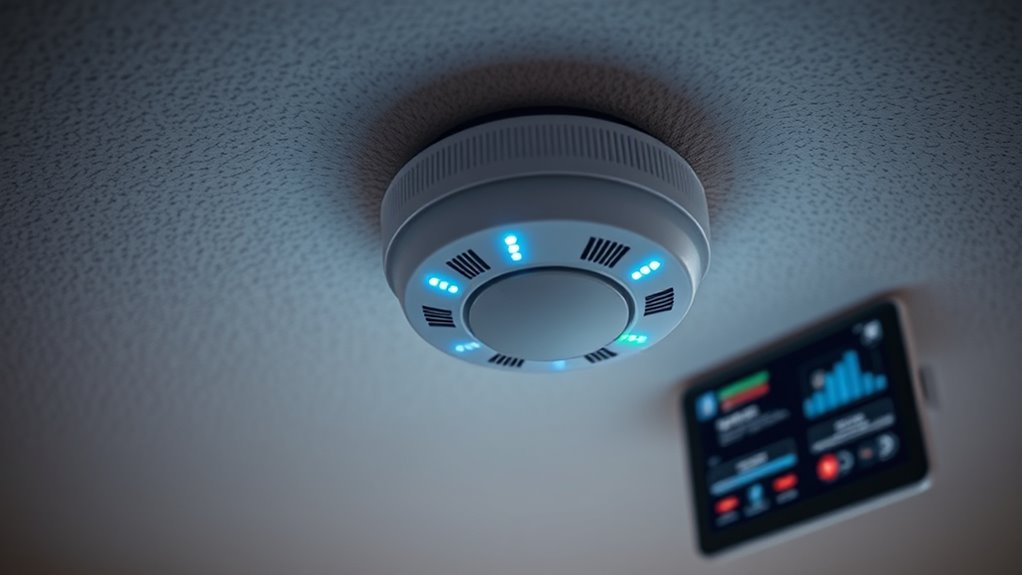
When your IoT smoke detector detects a fire, it can communicate directly with monitoring centers and emergency services to guarantee a rapid response. This immediate communication enhances fire prevention by ensuring help arrives quickly, reducing damage and saving lives. The device uses advanced smoke detection techniques, such as photoelectric sensors, to identify even small traces of smoke early. Once a threat is confirmed, it sends alerts through Wi-Fi or cellular networks, bypassing the need for manual calls. This seamless connection allows emergency responders to be notified instantly, often before you even realize there’s a problem. Additionally, these devices may integrate with fire safety protocols to ensure comprehensive protection. By integrating these smart communication features, IoT smoke detectors play a crucial role in proactive fire prevention and swift emergency response, making your home safer and more resilient.
Data Encryption and Security in IoT Smoke Alarm Communications
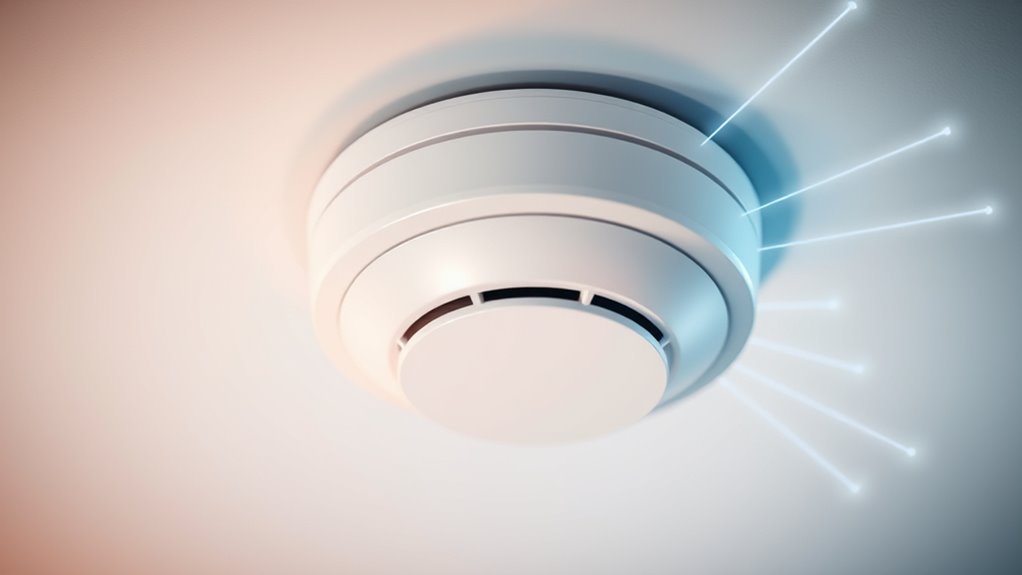
As IoT smoke detectors transmit sensitive information about your home’s safety, ensuring the security of this data is essential. Data encryption protects your alerts and personal data from unauthorized access during transmission. Strong user authentication verifies that only trusted devices can communicate with your smoke detector, preventing malicious interference. To keep your system secure, consider these key points:
- Implement end-to-end data encryption to safeguard communication.
- Use multi-factor user authentication for device access.
- Regularly update firmware to patch security vulnerabilities.
- Limit network access to authorized devices only.
Advantages of Silent Alerts Over Traditional Sirens
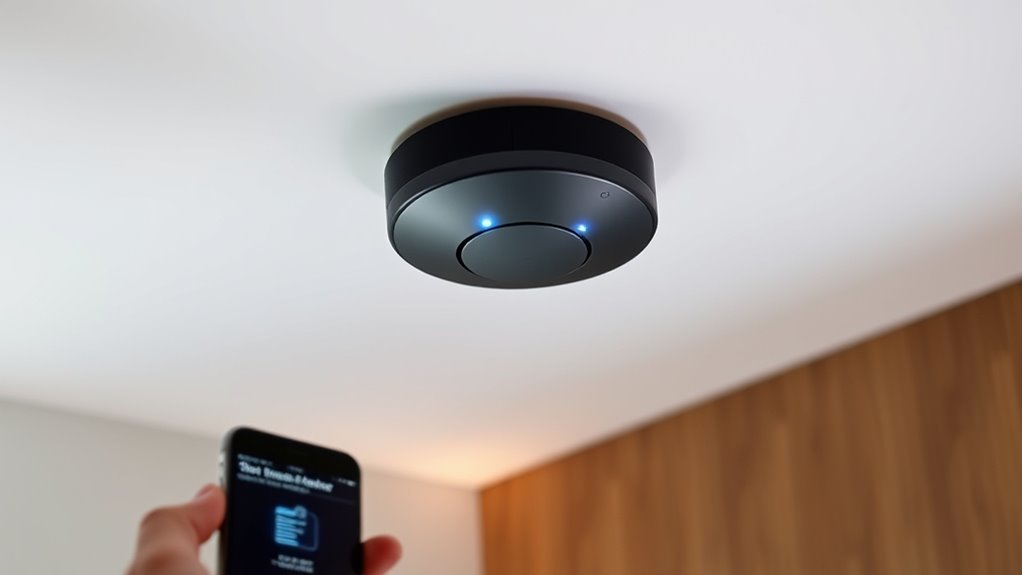
Silent alerts provide discreet emergency notifications, so you’re alerted without causing panic or disturbance. They also help reduce noise pollution, making your environment more peaceful during alarms. This quiet approach offers a more considerate and effective way to stay safe. Additionally, integrating silent alerts with other wellness features can promote a more mindful response to emergencies, enhancing overall safety protocols.
Discreet Emergency Notifications
Have you ever been startled by a loud siren during a fire emergency? Discreet emergency notifications offer a calmer, more effective way to ensure fire safety. These silent alerts inform you immediately via your smartphone or smart home system, reducing panic and confusion. Unlike traditional sirens, they prevent unnecessary alarm in quiet environments like hospitals or offices. Proper sensor calibration assures these alerts are accurate, avoiding false alarms or missed signals. Here are four key benefits:
- Minimize stress during emergencies
- Enable quick, targeted responses
- Prevent unnecessary disruptions
- Improve overall safety awareness
Silent alerts keep you informed without disturbing others, making them a smarter choice for modern fire safety. Their discreet nature enhances safety while maintaining peace in sensitive settings.
Reduced Noise Pollution
Traditional fire sirens generate loud, disruptive sounds that can disturb nearby residents and sensitive environments. These noisy alerts often cause unnecessary panic and can be especially problematic in hospitals, schools, or quiet neighborhoods. With IoT smoke detection, alerts are silent or discreet, substantially reducing noise pollution. This approach enhances fire safety by providing immediate notifications without disturbing the peace or causing stress. Silent alerts ensure that emergency responders and residents receive timely information without the chaos of blaring sirens. By minimizing noise, IoT smoke detectors support a calmer, safer environment while maintaining effective fire safety measures. This silent communication helps prevent the adverse effects of loud alarms, making smoke detection more considerate and efficient in sensitive settings.
Power Sources and Backup Systems for Continuous Operation
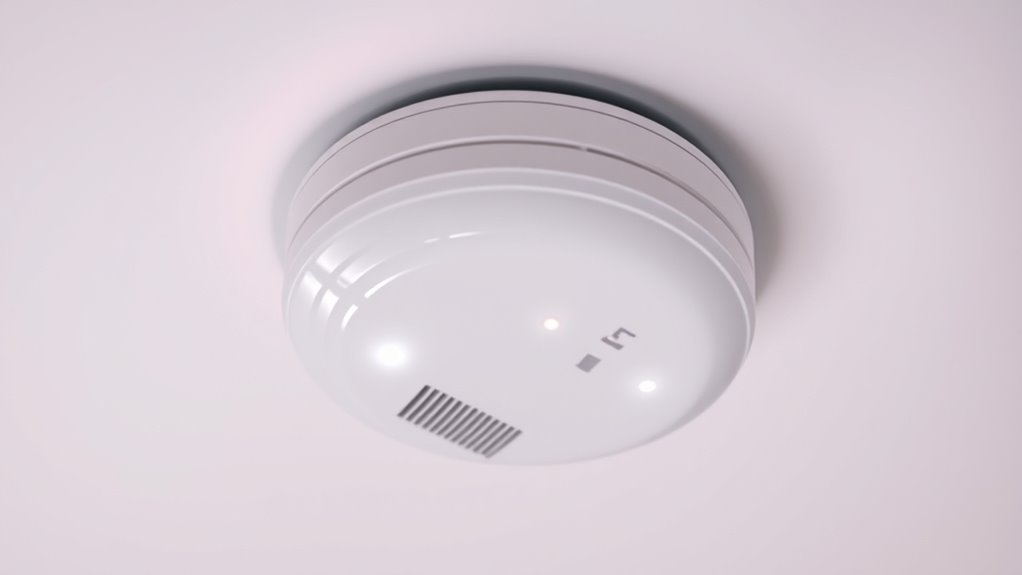
Ensuring continuous operation of IoT smoke detectors requires reliable power sources and effective backup systems. You rely on consistent power to maintain safety and timely alerts. Good power management extends battery longevity, reducing maintenance and ensuring readiness during outages. Backup systems are essential in case of power failure. Consider these key points:
- Use high-capacity batteries for longer lifespan.
- Incorporate automatic switching to backup power sources.
- Schedule regular maintenance to monitor battery health.
- Choose detectors with low power consumption to optimize battery life.
Future Trends in IoT Smoke Detection Technologies
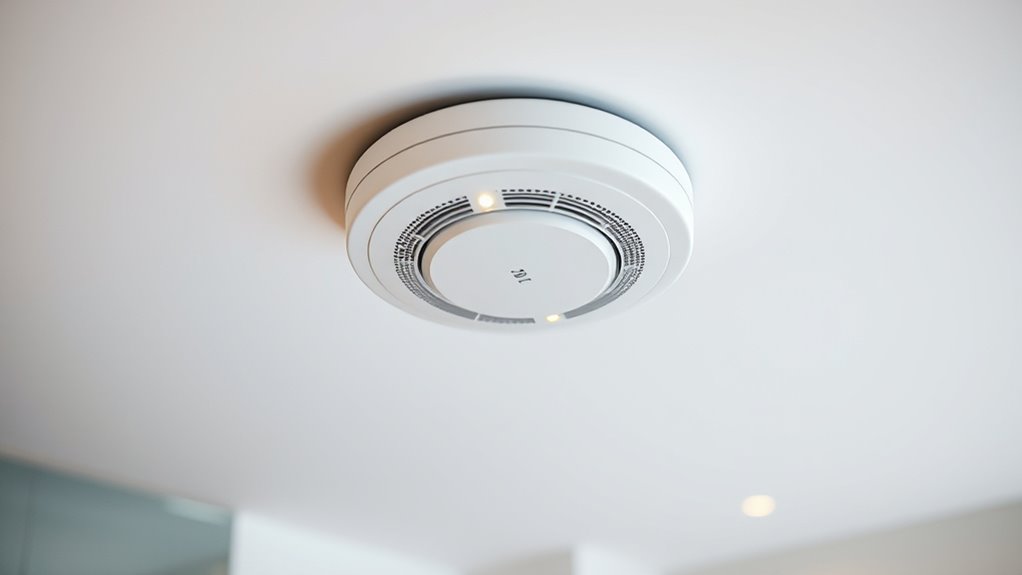
Advancements in IoT sensor technology and data processing are driving significant innovations in smoke detection systems. Future trends focus on smarter sensors with improved calibration techniques, ensuring greater accuracy and fewer false alarms. Enhanced sensor calibration will allow detectors to adapt to environmental changes more effectively. User interfaces are also evolving; expect more intuitive controls and real-time alerts accessible via smartphones or voice commands. Integration with smart home systems will enable seamless automation, like activating sprinklers or notifying emergency services instantly. Machine learning algorithms will analyze sensor data more precisely, predicting fire risks before flames appear. These innovations will make IoT smoke detectors more reliable, user-friendly, and capable of providing faster, silent lifesaving signals in emergency situations.
Frequently Asked Questions
How Do Iot Smoke Detectors Differentiate Between False Alarms and Real Fires?
You might wonder how IoT smoke detectors tell false alarms from real fires. They use fire pattern analysis to identify typical fire signatures, like smoke density and heat changes. Regular sensor calibration keeps these detectors accurate, reducing false alarms. When unusual patterns match fire behavior, the system alerts you immediately. This smart analysis guarantees you’re warned only when there’s a genuine threat, keeping you safe without unnecessary disruptions.
Can Iot Smoke Detectors Be Integrated With Other Home Security Devices?
Imagine your smart home as a symphony, where each device plays in harmony. Yes, IoT smoke detectors can be integrated with other home security devices through smart home integration and security system compatibility. This seamless connection allows your alarm to trigger cameras, lights, or alerts automatically, enhancing safety. You can monitor everything from one app, making your home smarter and more secure without missing a beat.
What Maintenance Is Required to Ensure Continuous Operation of Iot Smoke Detectors?
To keep your IoT smoke detector working reliably, you need to perform regular maintenance. This includes replacing the batteries when they run low and calibrating the sensors periodically to ensure accurate detection. Check the device monthly for any alerts or malfunctions. Keep the detector clean and free of dust. Proper maintenance guarantees your safety system functions seamlessly, providing ongoing protection and peace of mind.
Are There Specific Regulations Governing Iot-Based Fire Detection Systems?
You should know that regulations governing IoT-based fire detection systems focus on regulatory compliance and certification standards. These rules guarantee your system meets safety and performance criteria, often varying by region. Stay updated on local fire safety codes and industry standards, and ensure your IoT smoke detectors are certified accordingly. Compliance not only keeps you within legal requirements but also guarantees reliable, lifesaving performance when it matters most.
How Do Iot Smoke Detectors Perform in Extreme Environmental Conditions?
Did you know that IoT smoke detectors are designed to operate reliably in extreme conditions? You’ll find that their sensor durability and environmental resilience are key features, allowing them to withstand high temperatures, humidity, and dust. These detectors use advanced materials and protective enclosures, ensuring they perform consistently. So, even in harsh environments, you can trust your IoT smoke detector to alert you promptly and keep your space safe.
Conclusion
As IoT smoke detectors evolve, the silent signals they send could change everything you thought you knew about safety. Imagine a world where alarms alert you instantly, without noise, yet with absolute certainty. The future holds breakthroughs that might keep you one step ahead of danger—if you stay alert to these silent sentinels. Are you ready to embrace the next wave of lifesaving technology before it’s too late?

